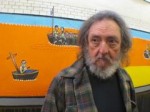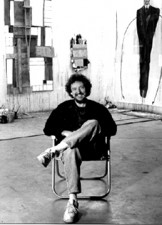
Luis Cruz Azaceta
Cuban, 1942- (active USA)
Double Self-Portrait: Aggressor/Victim, 1987
acrylic on canvas
105 ¾ x 77 in.
SBMA, Museum Purchase, with funds provided by the Twentieth-Century Art Acquisition Fund and, in part, by Dr. and Mrs. Aaron Nisenson
1994.9

Azaceta standing in front of his painting, Tub, 2009.
He says he doesn't include self-portraits "as a narcissist to display myself, but as a vehicle to convey certain political and social conditions; an actor playing different roles. I can make a self portrait as an aggressor or a victim."
RESEARCH PAPER
Azaceta left Cuba at age eighteen specifically to get away from the aftermath of the revolution led by Fidel Castro against the Batista regime. Society had changed to a violent one where he witnessed man’s inhumanity toward man and where he had to deal with a lot of violence as he was growing up. He remembers that fear was his prime emotion during the revolution:
“It was totally surreal. All of this comes out in my work…. I deal with fears, phobias and taboos, also black magic in a way. I use a lot of large severed heads in my paintings…. I use self-portraits as a vehicle to convey these conditions. In my work the heads are always screaming…Fear motivates my work…I paint to kill La Muerta, (death), and also to kill cruelty, injustice, violence, ignorance and hypocrisy.”
He arrived in America not speaking English and he lived among other immigrants, which he felt led to his isolation. He arrived at a time when America was experiencing it’s own fragmentation within due to the Vietnam War, causing further isolation and upheavals between the hawks and doves at a time that the counter-culture was in full bloom. All of the chaos fed into his sense of alienation and feelings of isolation in a new country.
As a child he drew pictures, but had never thought of being an artist. However, perhaps because of what he encountered in the sixties, he now looks back to remember the day he wandered into an art supply store to purchase some art materials-the day that president John Kennedy was shot. That memorable shot jogged him into starting to draw for his own pleasure. While working as a laborer and factory worker in the day he began taking evening classes in drawing and painting. He entered the Visual School of Art full-time at age twenty-four. Upon graduating, he went to Europe to study the Old Masters. He was heavily influenced by what he saw and learned. Moving from hard-edged abstractions, he did a complete turnaround in his style, which became boldly expressionistic. Not long after, he developed his personal approach to painting, which included drawing from memory and his imagination. He used no sketches, studies, or drawings, and no use of mirrors for his self-portraits, which are frequent in his paintings. He continues this approach to this day.
Azaceta has an extraordinary and unusual inventive mind. When one views his work one sees his reliance on imagination rather than on the physical world. He draws grotesque figures that remind one of Bosch. The unnerving violence he portrays, combined with his intense colors, more often than not, doesn’t have anything to do with reality. He plays and experiments with his colors but always maintains the underlying purpose of his art-the interpretation of the reality of the human condition. He looks at the urban world, and depicts the social ills, the psychological impact of culture shock as an immigrant in exile, poverty, criminality, homelessness, racism, AIDS, and drugs. These themes dominate his work. He was struck by the silence of people in the New York subways, compared to Cuba, where everyone spoke to everybody on public transportation. Occasionally he can slip into satire but usually it is macabre rather than humorous.
In all of this he uses self-portraiture to express his ideas of his personal experiences. Perhaps his most powerful feelings come from his experience of being an immigrant, not from a specific incident. He wants to encompass all peoples who have been downtrodden or displaced due to social intolerance from political, religious, and racial problems. The symbol of his exile is the drawing of the “Balsero,” a man adrift on the sea, which he was.
Azaceta distorted his figures for years and by the 1990s came to understand that he had been portraying an aspect of his own identity. He had been trying to come to terms with his personal experience of leaving his family, his homeland and his cultural roots. He is still on a spiritual search, always dealing with life and death. Azaceta’s allegorical views of himself and New York City are Kafkaesque, fearful and paranoid. He is frequently seen as an insect or mutilated survivor or a physically maimed creature. This is exemplified in Double Self-Portrait: Aggressor/Victim.
DESCRIPTION:
Boldly expressionistic, vivid colors, 8 legs/spider, flat, very little depth, reference to Pietà, African trickster spider myth, linear dark outline, double self-portrait, macabre, grotesque, startling
CONCLUSION:
Art critic, Justin P. Fulkerson said:
"There are three qualifications that a good work of art must meet. The art must be eye-catching, it must convey and idea of a message, and it should have the ability to identify with its viewers".
One can say that Double Self-Portrait meets all three criteria or one can say it does not.
TIME LINE:
1960: Immigrated to America
1967: Becomes American Citizen
1969: Graduates From School of Visual Arts, New York City
1975: First major exhibit; Franklin Gallery, New York City
Prepared for the SBMA docent council by Bette K. Goldenring, 2001

Undated photo of a young Azaceta in his studio.
COMMENTS
Luis Cruz Azaceta was born on Easter Sunday, 1942. His parents were of Basque and Austrian ancestry; "Azaceta" means "from A to Z" in the Basque alphabet. He grew up in the Marianao section of Havana, where his father worked for 33 years for the Cuban Air Force as an airplane mechanic; his mother was a housewife.
Azaceta, (in 2009 at 67), sees the 90 miles of shark-infested ocean between the United States and his native Cuba as a watery Berlin Wall. For 50 years, many Cubans on the island have longed to cross over to a new life in the United States, and many Cuban exiles in this country have pined to return to the home they once knew. For well-known political reasons, the trip is very difficult, in either direction.
Azaceta said that for some, the desire to flee or to return "becomes like a mental trip, like a dream."
He tries to capture that sense of unreality in his work.
He has never allowed himself to be tied to one medium or another. He can be a color-crazy abstract painter, a wildly inventive junk sculptor, or a master collage maker who specializes in grids of snapshots. "Once the work becomes mechanical, then I stop right there, " he said of his mercurial style, "because I like to be surprised and engaged by the process of the work."
He's also the creator of many unflattering self-portraits. All of the tiny, mournful figures that haunt his canvases are him, too. Many images are of struggle, and even if he were to somehow escape, he'd still be trapped. There's no way out. Not physically. Not psychologically.
Azaceta's works always have a distinct political edge. Over the years his subjects have included the plight of the poor, the AIDS epidemic, the post-Katrina social meltdown, the loss of cultural treasures during the Iraq War, and, time and again, the Cuban-American experience.
But he often tempers his artistic outrage with touches of droll wit. "That little ingredient of humor gives my work a little punch," he said. In one painting, he used a flying saucer to wryly satirize America's fear of alien immigrants. In another he dreamily coated the surface of the map of Cuba with a continuous layer of cotton balls, as if it were a cloud - though he points out that the cotton could imply both injury and slavery as well. In still another, he ironically depicted suffering Cuban refugees aboard a fleet of makeshift boats, bobbing around in an enormous, sinister-looking bathtub.
During his time at the School of the Visual Arts, his fiery style made him a star among the expressionist painters that dominated the 1980s art scene, such as Francesco Clemente, Sandro Chia and Anselm Kiefer. In 1992, he and his New Orleans-born wife, artist Sharon Jacques, resettled in the Crescent City. Azaceta has been a regular in major local exhibits since, from a large-scale solo exhibit at the Contemporary Arts Center in 1993, to the New Orleans Museum of Art's New Orleans Triennial in 1997, to Prospect.1 New Orleans in 2008.
Azaceta tried to visit Cuba to attend an art exhibit in 2000, but he was denied entry. In 2010, it will be 50 years since he's seen his birthplace, which is still present in his art with titles like Swimming to Havana.
Does political art make a difference? Azaceta believes it does. "It's to create a consciousness in the viewer, " he said. "I hope that people will understand. The Cuban refugees going across the ocean -- people don't understand the circumstances. If I create a picture of that, it creates a certain understanding. If you reach a few people, that's the point of making art."
Arts writer Doug MacCash, for the Times-Picayune.
Thursday, December 17, 2009
SBMA CURATORIAL LABELS
Double Self-Portrait: Aggressor/Victim belongs to a body of work by Luis Cruz Azaceta from the late 1980s that addresses personal and universal themes of fear, death, and the human condition. As a teenager, the artist witnessed the violence of the Cuban Revolution. At the age of eighteen, Azaceta came to the United States, living with relatives in New Jersey and working in a factory. In 1966, he enrolled in the School of Visual Arts in New York. For Azaceta, the city was a place of intense hostility and isolation, having a profound impact on his expressionistic works.
- SBMA title card information, 2013
Luis Cruz Azaceta describes his work in general as a “tragic-comic outcry at man’s condition.” To communicate this perspective, he draws upon emotionally potent symbols from pre-Columbian mythology and Christian iconography. His consistent use of self-portraiture further enables Azaceta to “convey different conditions and situations, much like the actor assuming a role on stage.”
In this painting Azaceta role-plays a sado-masochistic Pietà and an anthropomorphic pre-Columbian spider deity. Effectively blurring the distinction between the torturer and the tortured, the artist’s double image addresses a pattern of human violence.
- SBMA Wall Text, 2000
